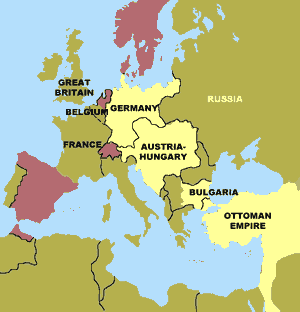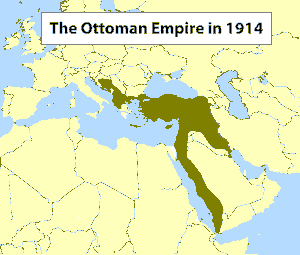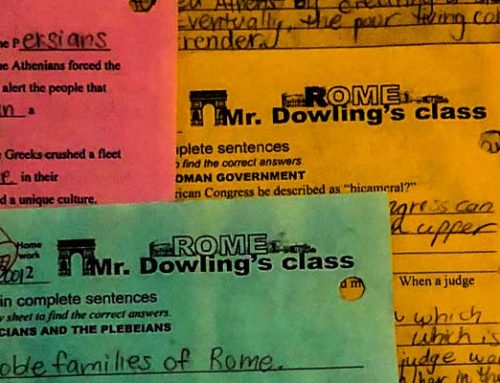Austria-Hungary declared war on Serbia in July 1914, one month after Francis Ferdinand’s death. Austria-Hungary’s close ally, Germany, joined the fight a month later. By November, they were joined by the weakened Ottoman Empire.
Present-day Turkey is a remnant of the Ottoman Empire. In the nineteenth century, the Ottoman Empire extended from Algeria in the west to Mesopotamia in the east. But on the eve of World War I, the empire had lost territory, and Ottoman control over its holdings beyond Asia Minor was weak. Writers of the time called the Ottoman Empire “the sick man of Europe.” Many people believed it was only a matter of time before one of the European colonial powers conquered part or all of the six-hundred-year-old Ottoman Empire.

The_Central_Powers
The Central Powers of World War I are shown in yellow. Austria-Hungary declared war in July 1914. Germany followed a month later. Turkey and Bulgaria joined the conflict in 1916.
A group of military officers called the Young Turks seized control of the Ottoman Empire in a 1908 revolution. The Young Turks decided to join the Great War on the side of the Central Powers, as it seemed Germany would win the conflict. The Turks feared Russia, one of the Allied Powers. Russia was north of Turkey and wanted access to what the Russians called a “warm water port.” The Russians had no direct access to the sea trade in the Black Sea and the Mediterranean Sea. All of Russia’s other ports at that time froze during the winter months. The Young Turks feared if they did not enter the war, Russia would conquer part of Turkey to gain access to the Black Sea.
The Young Turks were also convinced that a victory against Russia would allow the empire to regain land lost to Russia in Central Asia. At the beginning of World War I, Great Britain’s empire included India, east of Mesopotamia. The Young Turks believed their needs would be best met by joining forces against these two rivals.

The_Dogs_of_War
This cartoon from the British magazine Punch, describes Russia releasing the “dogs of war" on the Ottoman Empire as the European policeman looks on.
The Ottoman Empire signed a treaty with Germany in August 1914 and, within weeks, sent troops into battle. The following year, Bulgaria also joined the war on the side of the Central Powers, hoping to gain land from Serbia once the Allies were defeated. At the beginning of the Great War, many observers believed the Central Powers to be the strongest alliance in history.
Resources
Download this lesson as Microsoft Word file or as an Adobe Acrobat file.
Listen as Mr. Dowling reads this lesson.
Mr. Donn has an excellent website that includes a section on World War I and World War II.





